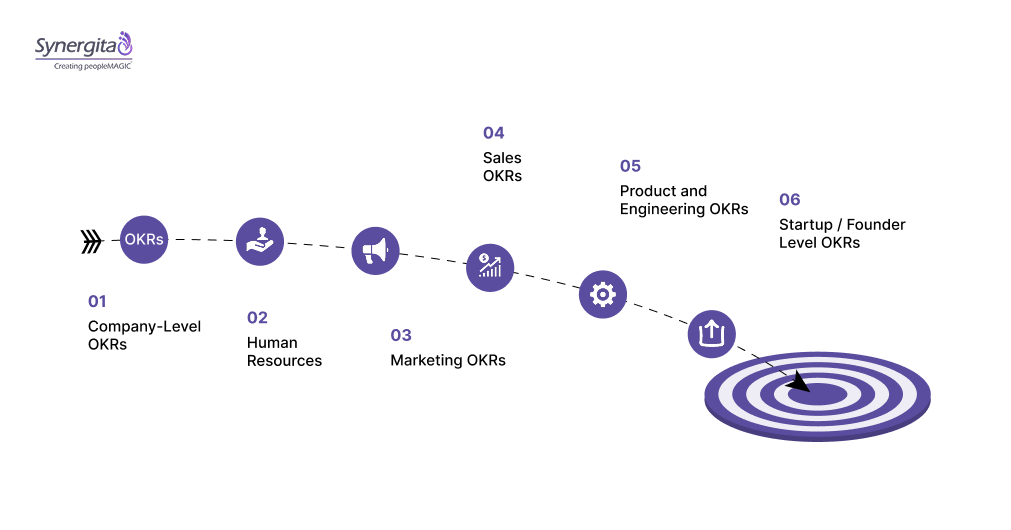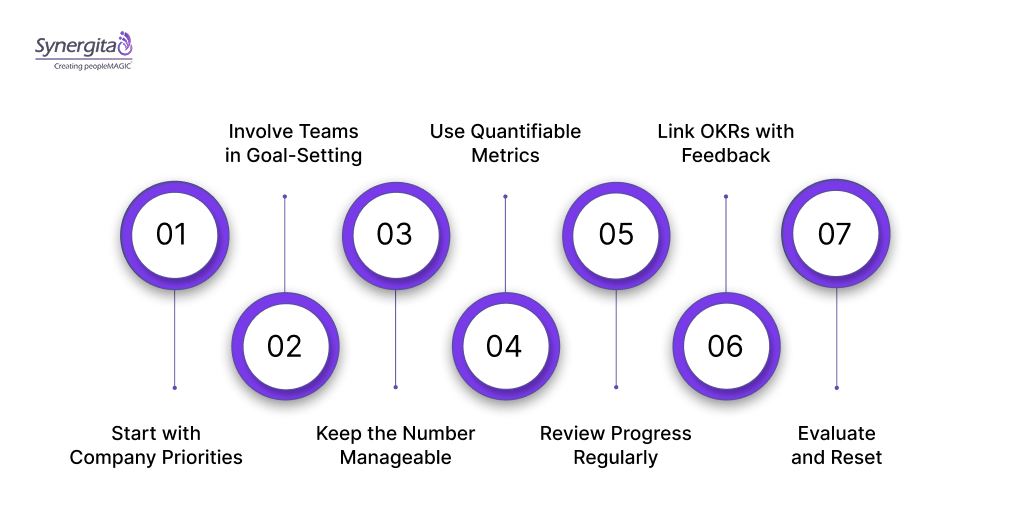Clear, measurable goals drive performance. Yet many organizations still find it difficult to connect everyday work with long-term strategy.
The Objectives and Key Results (OKR) framework bridges that gap by translating broad objectives into quantifiable, time-bound results. It helps teams align, measure, and adapt their efforts with transparency.
According to recent studies, 46.7% of organizations have adopted OKRs across their structure. Gartner also reports that companies following human-centric goal-setting practices are 3.8 times more likely to achieve high employee performance.
When implemented correctly, OKRs create visibility and accountability at every level, so employees understand not just what to achieve but how success will be measured.
Key Takeaways:
- OKRs turn ambitious goals into measurable outcomes that improve focus and accountability.
- Strong OKRs are clear, aligned, and supported by quantifiable key results.
- Regular check-ins and progress reviews are critical to maintaining goal visibility.
- Limiting OKRs to a few high-impact objectives helps teams stay results-driven.
- A unified platform simplifies goal alignment, performance tracking, and engagement.
What Makes a Good OKR: Quick Checklist
A well-written OKR connects ambition with action. It defines what you want to achieve and how you will measure progress.
Structure
- Objective: A clear, inspiring statement of intent.
- Key Results: 3–5 measurable outcomes that prove the objective is achieved.
Traits of Effective OKRs
- Clarity: Everyone understands the goal without interpretation.
- Measurability: Each key result includes a metric, value, or target range.
- Alignment: Objectives link directly to team or company priorities.
- Focus: Teams commit to a few key outcomes, not a long list of tasks.
- Time-Bound: Each OKR is tied to a defined review cycle—quarterly or monthly.
- Stretch-Oriented: Targets encourage growth without being unrealistic.
Quick OKR Audit
Before finalizing an OKR, ask:
- Is the objective outcome-focused or just an activity?
- Are key results measurable and time-bound?
- Does this OKR directly support a higher-level business goal?
- Will progress be reviewed regularly?
When these conditions are met, OKRs become a reliable framework for both alignment and accountability, helping organizations turn strategy into measurable progress.
Examples of Good and Bad OKRs
Many organizations confuse activity-based goals with outcome-driven OKRs. A well-designed OKR focuses on measurable impact rather than effort.

Below are simple comparisons showing how wording and structure affect clarity, focus, and accountability.
Example 1: Improving Customer Satisfaction
Bad OKR
- Objective: Make customers happier.
- Key Results:
- Respond to more customer queries.
- Conduct a feedback survey.
Why it fails: The objective is vague, and key results describe actions, not measurable outcomes.
Good OKR
- Objective: Improve customer satisfaction across all support channels.
- Key Results:
- Increase Net Promoter Score (NPS) from 60 to 75.
- Reduce average support response time from 24 hours to 6 hours.
- Achieve 90% positive feedback in post-ticket surveys.
Why it works: Each key result is quantifiable and tied to a specific performance metric.
Example 2: Strengthening Team Collaboration
Bad OKR
- Objective: Improve collaboration.
- Key Results:
- Conduct more team meetings.
- Share project updates frequently.
Why it fails: The OKR focuses on frequency of meetings, not the quality or outcomes of collaboration.
Good OKR
- Objective: Build stronger cross-functional collaboration among departments.
- Key Results:
- Launch two cross-team projects this quarter.
- Achieve 85% participation in biweekly planning sessions.
- Reduce project handoff delays by 20%.
Why it works: It measures collaboration through results—participation, cross-team output, and efficiency improvements.
Example 3: Enhancing Employee Engagement
Bad OKR
- Objective: Increase employee engagement.
- Key Results:
- Send internal newsletters.
- Organize more activities.
Good OKR
- Objective: Strengthen employee engagement and feedback participation.
- Key Results:
- Achieve an employee engagement score of 80% or higher.
- Ensure 100% completion rate for quarterly feedback surveys.
- Conduct one engagement activity per month with >70% participation.
Why it works: It translates engagement into measurable behavioral outcomes rather than routine actions.
When OKRs are written with specific, data-based results, teams can track progress objectively and link goals to organizational impact.
OKR Examples by Department
Strong OKRs connect company strategy with team-level outcomes. The following sample OKRs illustrate how different functions can use measurable goals to align performance and growth.

A. Company-Level OKRs
Objective 1: Strengthen overall business growth.
- KR 1: Increase quarterly revenue by 15%.
- KR 2: Achieve a customer retention rate of 90%.
- KR 3: Launch two new market initiatives by Q4.
Objective 2: Improve company-wide operational efficiency.
- KR 1: Reduce average project turnaround time by 20%.
- KR 2: Automate 50% of manual reporting tasks.
- KR 3: Maintain a 95% on-time delivery rate across all teams.
B. Human Resources / People Operations
Objective 1: Boost employee engagement and satisfaction.
- KR 1: Achieve an employee engagement score ≥ 80%.
- KR 2: Ensure 100% completion of quarterly pulse surveys.
- KR 3: Implement three new recognition initiatives within 6 months.
Objective 2: Strengthen hiring and onboarding processes.
- KR 1: Reduce average time-to-hire from 40 to 25 days.
- KR 2: Increase new-hire retention after 6 months to 90%.
- KR 3: Attain an onboarding satisfaction score of 85% or higher.
C. Marketing OKRs
Objective 1: Grow brand awareness and qualified traffic.
- KR 1: Increase organic website sessions by 30%.
- KR 2: Earn coverage in 5 industry publications.
- KR 3: Boost social media engagement rate by 25%.
Objective 2: Generate higher-quality inbound leads.
- KR 1: Improve MQL-to-SQL conversion by 20%.
- KR 2: Reduce cost-per-lead by 15%.
- KR 3: Launch 8 SEO-optimized content pieces per month.
D. Sales OKRs
Objective 1: Increase new revenue generation.
- KR 1: Close $1.5 million in new business this quarter.
- KR 2: Improve win rate from 28% to 35%.
- KR 3: Shorten average sales cycle from 60 to 45 days.
Objective 2: Strengthen customer relationships.
- KR 1: Conduct quarterly business reviews with 100% of key accounts.
- KR 2: Achieve customer satisfaction score ≥ 90%.
- KR 3: Upsell to 30% of existing customers.
E. Product and Engineering OKRs
Objective 1: Accelerate product delivery and innovation.
- KR 1: Ship 3 major releases per quarter.
- KR 2: Reduce post-release bugs by 25%.
- KR 3: Improve sprint completion rate to 95%.
Objective 2: Enhance user experience.
- KR 1: Increase daily active users by 20%.
- KR 2: Achieve product NPS ≥ 70.
- KR 3: Cut feature adoption drop-off to <10%.
F. Startup / Founder Level OKRs
Objective 1: Build a scalable business foundation.
- KR 1: Reach monthly recurring revenue of $100K.
- KR 2: Maintain a customer acquisition cost < $200.
- KR 3: Raise Series A funding by Q4.
Objective 2: Strengthen team alignment and execution.
- KR 1: Conduct company-wide OKR planning every quarter.
- KR 2: Achieve 90% OKR completion rate.
- KR 3: Hold biweekly check-ins with all team leads.
Well-structured OKRs like these help teams maintain focus, align with company goals, and evaluate performance using quantifiable results.
How to Implement and Track OKRs Effectively
Writing good OKRs is only the first step. The real impact comes from consistent tracking, transparent reviews, and regular alignment across teams.

- Start with Company Priorities: Define 3–5 top-level objectives that support annual business goals. Every team’s OKRs should cascade from these priorities, creating a clear link between strategy and execution.
- Involve Teams in Goal-Setting: Engage managers and employees while defining OKRs. Collaborative planning ensures buy-in and helps individuals see how their work contributes to larger outcomes.
- Keep the Number Manageable: Most successful organizations limit OKRs to 3–4 objectives per team with 3 measurable key results each.
Fewer, well-defined goals make tracking and course correction easier. - Use Quantifiable Metrics: Track only what can be measured objectively—percentages, revenue values, engagement scores, or completion rates.
Avoid activity-based key results like “send weekly updates” that don’t reflect outcomes. - Review Progress Regularly: Schedule weekly or bi-weekly check-ins to discuss progress, blockers, and alignment. Consistent reviews prevent end-of-quarter surprises and encourage timely course corrections.
- Link OKRs with Feedback and Recognition: Tie goal progress to performance discussions. Recognize individuals and teams that achieve or exceed their OKRs—this builds accountability and motivation.
- Evaluate and Reset: At the end of each cycle, evaluate which objectives were met, what caused delays, and how future OKRs can be refined. Continuous iteration keeps the framework relevant and adaptive.
When implemented with discipline, OKRs transform from a planning tool into a continuous performance system—helping teams stay focused, aligned, and data-driven throughout the year.
Why Synergita Is the All-in-One Platform for OKRs + People Management
Managing OKRs effectively requires more than templates or spreadsheets. It needs a platform that connects goal alignment, performance tracking, and employee engagement in one ecosystem.

Synergita delivers that integration through a suite of connected modules designed for HR teams, managers, and growing organizations.
1. Unified OKR and Performance Framework: Synergita lets organizations set, cascade, and track OKRs at every level—from company goals to individual objectives.
2. Continuous Performance Feedback: Unlike static review systems, Synergita encourages ongoing check-ins, feedback exchanges, and recognition.
3. Data-Driven Insights and Analytics: Built-in analytics provide actionable metrics such as OKR achievement rates, performance trends, and sentiment scores.
4. Flexibility for Every Organization: Synergita offers modular editions—Perform, Perform Plus, Engage, and OKR—allowing teams to scale features as they grow.
5. Proven Impact: Organizations using Synergita report faster goal alignment, improved employee participation, and stronger performance visibility across departments.
When OKRs, feedback, and analytics work together, strategy becomes execution.
Synergita makes that connection seamless—helping businesses turn goals into measurable results and people into engaged contributors.
Conclusion
OKRs bring structure, focus, and accountability to how organizations set and achieve goals. When written with clarity and tracked consistently, they turn strategy into measurable performance.
But success with OKRs depends on more than writing good objectives—it requires ongoing alignment, transparent progress reviews, and the right digital framework to manage everything in one place.
That’s exactly what modern platforms like Synergita enable. By combining OKR tracking, performance reviews, and engagement analytics, organizations can build a continuous performance culture where every goal is visible, measurable, and achievable.
Turn your team’s goals into measurable outcomes.
Get started with Synergita today.
FAQs
1. What is the best format for writing OKRs?
The most effective way to write OKRs is to keep them clear and measurable. Each OKR should begin with an Objective that defines what you want to achieve, followed by three to five Key Results that describe how success will be measured.
2. How many OKRs should a team set per quarter?
Teams achieve the best outcomes when they limit themselves to three or four objectives per quarter, with about three measurable key results per objective. Keeping OKRs minimal ensures clarity and focus, allowing teams to stay aligned and track progress more effectively.
3. What are examples of good OKRs for collaboration?
A good collaboration OKR focuses on outcomes rather than activities. For example, a team could set an objective to strengthen cross-department teamwork, with measurable results such as launching cross-functional projects, increasing participation in planning sessions, or reducing project handoff delays.
4. How do OKRs differ from KPIs?
OKRs and KPIs serve different purposes. KPIs measure ongoing business performance against stable metrics like customer retention or revenue growth, while OKRs define short-term, aspirational goals that drive change and improvement. In simple terms, KPIs tell you how you’re performing, and OKRs show where you want to go next.
5. How often should OKRs be reviewed or updated?
Regular review is essential to make OKRs work. Teams should hold weekly or bi-weekly check-ins to discuss progress, identify challenges, and adjust timelines when necessary. At the end of each quarter, OKRs should be evaluated for completion, and new objectives can be set based on learnings from the previous cycle.



